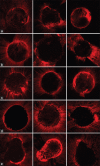Comparison of the penetration depth of five root canal sealers: A confocal laser scanning microscopic study
- PMID: 34759590
- PMCID: PMC8562833
- DOI: 10.4103/JCD.JCD_364_19
Comparison of the penetration depth of five root canal sealers: A confocal laser scanning microscopic study
Abstract
Background: Sealer penetration into dentinal tubules eliminates the pathways for bacterial leakage and entombs intratubular bacteria.
Aim: The aim of this study was to evaluate and compare the depth of radicular dentinal tubule penetration of five root canal sealers using confocal laser scanning microscopy.
Methods: Fifty freshly extracted single-rooted maxillary anterior teeth were used. After decoronation at the cementoenamel junction, they were prepared to ProTaper size F3. After irrigation with 5 mL smear clear, 5 mL 5% sodium hypochlorite and 5 mL distilled water alternatively, the samples were randomly divided into five groups (n = 10) and obturated by lateral compaction technique using the test sealers labeled by fluorescent rhodamine B dye (Mayor Diagnostics, Mumbai, India). Zinc oxide eugenol (ZOE) (Prime Dental Products), EndoREZ (Ultradent), Sealapex (SybronEndo), AH Plus (Dentsply Maillefer), and MTA-Fillapex (Angelus) formed the test groups. Teeth were then positioned in blocks of orthodontic resin. Three horizontal sections of 1-mm representing coronal middle and apical thirds were made and examined with Zeiss (laser scanning microscope [LSM] 780) confocal LSM. Images were analyzed using ZEN 2.1 software.
Statistical analysis: Data were recorded and subjected to statistical analysis using one-way ANOVA test.
Results: Maximum penetration depth was demonstrated by AH Plus in the coronal and apical thirds, MTA-Fillapex in the middle thirds, while minimum penetration depth was seen in ZOE in the coronal and middle thirds and Sealapex in the apical thirds. None of the root canal sealers were able to penetrate the complete depth of radicular dentinal tubules.
Conclusion: While AH Plus and MTA-Fillapex showed the highest penetration into radicular dentinal tubules, ZOE and Sealapex demonstrated the least penetration.
Keywords: Confocal laser scanning microscopy; dentinal tubule; depth penetration; rhodamine B; root canal sealers.
Copyright: © 2021 Journal of Conservative Dentistry.
Conflict of interest statement
There are no conflicts of interest.
Figures


References
-
- Nair PN. Pathogenesis of apical periodontitis and the causes of endodontic failures. Crit Rev Oral Biol Med. 2004;15:348–81. - PubMed
-
- Peters LB, van Winkelhoff AJ, Buijs JF, Wesselink PR. Effects of instrumentation, irrigation and dressing with calcium hydroxide on infection in pulpless teeth with periapical bone lesions. Int Endod J. 2002;35:13–21. - PubMed
-
- Siqueira JF, Jr, Rôças IN, Lopes HP, de Uzeda M. Coronal leakage of two root canal sealers containing calcium hydroxide after exposure to human saliva. J Endod. 1999;25:14–6. - PubMed
-
- Sen BH, Pişkin B, Baran N. The effect of tubular penetration of root canal sealers on dye microleakage. Int Endod J. 1996;29:23–8. - PubMed
-
- Okşan T, Aktener BO, Sen BH, Tezel H. The penetration of root canal sealers into dentinal tubules. A scanning electron microscopic study. Int Endod J. 1993;26:301–5. - PubMed
LinkOut - more resources
Full Text Sources
Miscellaneous
